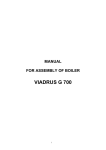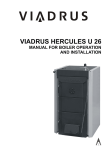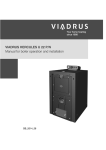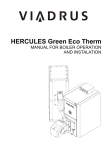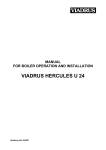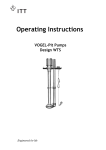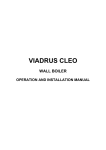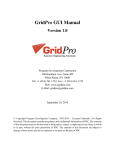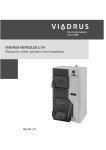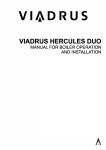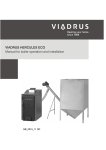Download Viadrus G 300 Installation manual
Transcript
CALOR SRL Str. Progresului nr. 30-40, sector 5, Bucuresti tel: 021.411.44.44, fax: 021.411.36.14 www.calorserv.ro - www.calor.ro BOILER OPERATION AND INSTALLATION MANUAL VIADRUS G 300 Date of revision 8/2007 Table of contents: page 1. Boiler use and advantages....................................................................................................................................3 2. Boiler VIADRUS G 300 technical data ............................................................................................................4 3. Description..........................................................................................................................................................5 3.1. Boiler construction...................................................................................................................................... 5 3.2. Electrical diagrams....................................................................................................................................... 6 4. Positioning and installation................................................................................................................................10 4.1. Boiler standing in boiler room ................................................................................................................... 10 4.2. Directives and regulations......................................................................................................................... 11 5. Order, delivery and assembly............................................................................................................................12 5.1. Order .......................................................................................................................................................... 12 5.2. Delivery and accessories............................................................................................................................ 12 5.3. Assembly process...................................................................................................................................... 12 6. Commissioning ..................................................................................................................................................12 6.1. Checking activities before initiation ......................................................................................................... 12 6.2. Boiler conversion from „ liquid fuels“ to „ gas fuels“ and back............................................................... 13 7. Boiler operation by user....................................................................................................................................13 8. Maintenance.......................................................................................................................................................14 9. Instructions for product disposal after its service life ........................................................................................15 10. Failures and their elimination ........................................................................................................................15 2 Dear customer we thank you that you decided to purchase VIADRUS G 300 boiler thus showing your confidence in company of ŽDB GROUP a.s., VIADRUS Heating technique plant. For you to get used to operating your new product correctly from the start please read carefully this manual instructing you how to use the product (first of all chapter No.7 - Boiler operation by user). Please follow the information stated in further text and also the Regulation No.91/93 Coll.. issued by Czech Labour Safety Office for ensuring the labour safety in law-pressure boiler rooms; this will guarantee a long-time and failure-free boiler operation to both your and our satisfaction. Order: Order specification code (type designation) G 300 X X X X Number of sections : 5: 5 sections 6: 6 sections 7: 7 sections 8: 8 sections 9: 9 sections 10: 10 sections 11: 11 sections 12: 12 sections 13: 13 sections 14: 14 sections The way of delivery: S : compound/ assembled state R : decomposed/disassembled state Type of regulation: 4: Electropanel – basic design 6: Electropanel - fixed OS 06 Type of burner: 0: no burner 1: with burner In the order it is necessary to specify the data according to the specification code order 1. Boiler use and advantages Cast-iron sectional warm-water boiler VIADRUS G 300 is designed for heating the heat carrying substance (water) by the thermal energy which it gets from gas or liquid fuels burning process while using the appropriate pressure burners. These burners must correspond to : ČSN 07 5800:1990 Burners for gas and liquid fuels ČSN 07 5806:1986 Burners for gas fuels ČSN 07 5853:1990 Burners for liquid fuels. The boiler is made exclusively for law-pressure warm-water systems of central heating with maximum working temperature of the heat-carrying substance (water) up to 115 °C, at the maximum working overpressure of 4 bar and for burning the fuels as follows: - gas fuels - natural gas - liquid fuels - furnace oil extra light (TOEL) The boiler body is tested by applying the test overpressure of 8 bar. The boiler advantages are as follows: 1. 2. Long service life of the cast-iron boiler body A highly economical operation . The efficiency of combustion higher than 90,5 % for all kinds of fuels and in the whole performance range. 3. At request delivery including the burner. 4. A modern design. 5. A fully automated two-stage operation at the recommended types of burners. 6. Operation signalling, possibly the signals used for transfer into a superior control system and the boiler failures. Possibility to operate the boiler through a superior automatics or space temperature sensor. 7. At request there can be ordered the regulation elements designed for heat carrying substance(water) temperature up to 115°C (as standard they are delivered up to the temperature of 95 °C). 8. Possibility of boilers concatenation. 9. Delivery in either an assembled or disassembled condition at customer ´s request 10. Depending on boiler room layout there can be designed opening of sealing and burner plate either to the left or right hand side. 11. Easily accessible sight glass and the probe for overpressure measuring in the combustion chamber . 12. In combination with recommended burners (see chapter„Boiler technical parameters“) spares of environment because the combustion results meet in the whole performance line the rigid environmental standards and regulations. 3 2. Boiler VIADRUS G 300 technical data Table No.1 Boiler thermo-technical parameters fuel efficiency : natural gas 33,99 MJ/kg Boiler size - number of ks 5 6 sections kW 103 126 Rated thermal output kW 113,2 138,5 Rated thermal input % Efficiency Fuels consumption natural gas m3/h 11,5 14,1 furnace oil extra light (TOEL) kg/h l 56,4 65,4 Boiler water volume Max. working water overpressure bar Max. operating temperature of °C heating water Combustion gas technical data Necessary draught mbar Max. overpressure in mbar combustion chamber Combustion gas temperature °C Combustion gas mass - gas fuel ; 9,5% CO2 kg/h 191 233 - liquid fuel ; 13%CO2 kg/h 172 210 Dimensions combustion space volume dm3 81,79 100,73 Heat-delivery surface m2 5,48 6,75 combustion space depth mm 475 585 min. length of burner orifice mm max. burner orifice at the mm combustion space mm orifice for burner φ *) boiler width mm boiler height mm boiler depth A mm 899 mm outlet orifice φ heat carrying substance mm connection φ kg 505 585 Boiler mass furnace oil extra light (TOEL) 42,65 MJ/kg 7 8 9 10 11 12 13 14 149 163,7 172 189 195 214,3 218 239,6 241 264,8 264 290,1 287 315,4 310 340,7 21,9 24,5 27,1 dle výrobce burneru 92,4 101,4 110,4 4 29,7 32,2 34,9 119,4 128,4 137,4 531 478 574 517 90,5 16,7 19,3 74,4 83,4 95 (115) 0,05 2 185 276 248 318 287 119,68 8,02 698 361 325 138,62 157,56 9,29 10,56 805 915 125 403 363 446 402 488 440 176,51 11,83 1025 195,45 13,10 1135 214,39 14,37 1245 233,33 252,27 15,64 16,91 1355 1465 160 50 150 165 752 1386 1339 225 119 1559 1779 80 665 745 825 905 985 1065 1145 1225 *) requirement for other orificeφ – please state in order (at request ) Tab. No.2 Recommended types of burners Boiler size - number pc of sections Rated thermal output kW 5 6 7 8 9 10 11 12 13 14 103 126 149 172 195 218 241 264 287 310 Recommended burners for gas fuels combustion WEISHAUPT WG 20 N/1 - A WG 30 N/1 - C WG 40 N/1-A INTERCAL SGN 44/2 SGN 55/2 SGN 66/2 SGN 77/2-350 BENTONE BG 300-2, M BG 400-2, M BG 450-2, M PBS Třebíč APH-M 02 PZN,PPN APH-M 04 PZN,PZ,PPN RIELLO GULLIVER BS 3D GULLIVER BS 4D RS 28 TC RS 38 TC Recommended burners for liquid fuels combustion WEISHAUPT WL 20-A WL 30 - C WL 40 Z-A INTERCAL SL 44/2 SL 55/2 SL 66/2 SL 77/2 BENTONE B 20K-2 B 30 - 2 B 40 - 2 PBS Třebíč AOH – M 02 PN AOH – M 04 PN RIELLO GULLIVER RG 3D GULLIVER RG 4D RL 28 TC RL 38 TC UNIGAS LO 140 LO 200 LO 400 LO 400 When using other than recommended burners the manufacturer doesn’t guarantee the stated parameters achievement. 4 3. Description 3.1. Boiler construction The boiler body (Fig. No.1) consists of sections assembled by means of forced-on insertions and is secured by anchor bolts. Boiler has a three-draught construction and the sections create the combustion space and the convection part, inside then the boiler water space. The tightness of boiler gas combustion space is guaranteed by boiler cement applied to sections seating faces and to circumference of individual section joints. On the front section there are fixed sealing and burner plates that either can be opened to right or left hand side according to boiler room layout. This must correspond with screw suspensions positioning (lugs). The openings G 2"in the front section are closed with plugs G 2". The upper plug has a boring G 1/2“ for the basin of regulation and safety thermostat. In the left upper riser of the section there are two openings G 1/2" for thermometer and pressure gauge sensors. The input and output of a heat carrying substance is situated at the rear part of boiler and it is carried out with flanges and a mouthpiece DN 80. At the lower flange with a mouthpiece there is positioned the filling & discharging cock. In the opening for heat carrying substance input (under the flange) there is positioned a restrictive insertion (5 – 10 sections and 11 – 14 sections), which streamlines the water flow in boiler. The combustion gases from the boiler are led/ taken away through a flue orifice with an explosion shutter which at the same time serves as a small cleaning cover. At the flue orifice there are measuring points for temperature and combustion gases analysis. The boiler body is fully insulated by plates made of mineral insulation . The steel shell of boiler is surface treated by comaxite paint. In the upper front part of boiler there is positioned the electro-panel with regulation, safety and control elements. Fig. No.1 Boiler assembly 5 Legend: F1 fuse 6,3 A S1 Main switch H1 Boiler under voltage signalling Z1 Suppression component BT1 Safety thermostat PS1 Water pressure manostat H2 Safety thermostat signalling K1 Eternal operation relay 6 BT2 Service thermostat X10 Burner connector H3 Burner defect signalling H4 Burner 2nd stage working signalling MPH1 Service hours gauge for 1st burner stage MPH2 Service hours gauge for 2nd burner stage BT3 Thermostat for 2nd burner stage X20 Burner connector COVER OF ELEKTROPANEL NOTE: Water pressure manostat (PS1)only in design for MORA company, in case it is used reconnect the conductor BT1:14 from terminal X1:8 to X1:9. The outside control relay 24AVC(K1) only in design for SLANT/FIN firm; in case it isn’t used reconnect the conductor X10: T1 from terminal X1:12 to X1:13. Conductor colour: GNYE green- yellow BK black RD dark red 3.2. Electrical diagrams Fig. No.2 Elementary wiring diagram for electro-panel connection Fig. No.3/1 Electro-panel wiring diagram 7 Cover of elektropanel Z1 Suppression component NOTE: Water pressure manostat (PS1) only in design for MORA company, in case it is used reconnect the conductor BT1:14 from terminal X1:8 to X1:9. – conductor nr.18. The outside control relay 24AVC(K1) only in design for SLANT/FIN firm; in case it isn’t used reconnect the conductor X10: T1 from terminal X1:12 to X1:13. PS1 Water pressure manostat X10 Burner connector X20 Burner connector A1 Outside control K1 relay 24 VAC COVER Fig. No.3/1 Electro-panel wiring diagram 8 network module S1 H1 Main switch Boiler under voltage signalling BT2 Service thermostat H2 Safety thermostat signalling H3 Burner defect signalling BT1 Safety thermostat H4 nd Burner 2 stage working signalling F1 fuse 6,3 A BT3 Thermostat for 2nd burner stage running hours counter MPH2 Service hours gauge for 2nd burner stage MPH1 Service hours gauge for st 1 burner stage RJ protected input boiler circulation 1 NPE 50 Hz 230 V/16 A pump boiler main switch Boiler bypass pump failure 9 boiler burner Note 1) bypass pump controlled by a thermostat master control BOILER REGULATION Fig. No.4 RZ 20 Regulation wiring diagram (OS 06) 4. Positioning and installation 4.1. Boiler standing in boiler room L of boiler + min. 500 The boiler is designed for positioning in closed areas with aggressiveness degree between a little up to moderately aggressive and in terms of electrotechnic regulations in a common environment (ČSN 33 2000 – 7 – 701:1997). It agrees with the use in rooms separated from housing room itself (Declaration 91/93 Coll.., ČSN 07 0703:1986 Gas boilers). Boiler noise level does not exceed the maximum level of LA = 75 dB(A) - (the real value depends on the type of used burner : for recommended types it ranges between 60 – 70 dB). The boiler must be positioned on a fireproof pad or a sustaining wall approx. 50 mm high. In front of boiler there must be left a free handling area minimum for the boiler depth + 500 mm, from one side 600 mm (access to the back). When positioning the boiler there must be respected the layout requirements of selected type of burner (gas inlet and others.) *) It is necessary to respect the selected type of burner layout requirements ( gas inlet , burner length etc.) Fig. No.5 Boilers positioning in boiler room For safety reasons at the installation there must be observed the distance of 200 mm from flammable substances (ČSN 06 1008:1997 – Fire safety of local appliances and heat sources). For easily flammable substances it means those that are quickly self-burning also after removing the source of inflammation (like tar paper, cardboard, asphalt and tar paper, wood and hardboards , plastic substances, flooring) the distance gets doubled. A safe distance must be doubled also in case that the building material flammability degree hasn’t been proved. In case that there is a danger of a temporary intrusion of combustible vapours or gases into the boiler room or at the works at which there temporarily occurs the fire & explosion danger (gluing the flooring, coats with combustible paints ) the boiler must be put out of operation in time and before the works commencement. Warning: No subjects made of flammable substances (see Fig. No.5) are allowed to be put on the boiler and within a distance smaller than the safety distance. Filling the heating system with water. The heating system must be thoroughly flushed out so that all impurities that could be deposited in distribution system and radiators are washed out because otherwise they could damage the pump. Water for filling the boiler and heating system must be clear and colourless , with no suspended substances, oil or chemically aggressive substances. The circulation and filling water parameters must correspond to: Tab. No.3 The highest permissible values of heating water according to ČSN 07 7401:1992 hardness Ca2+ Total Fe + Mn concentration *recommended value (mmol/l) (mmol/l) (mg/l) 1 0,3 3* In case that the water hardness is unsuitable it must be adjusted. Not even heating the water with higher hardness several times will prevent the soils precipitation on the boiler body walls. Precipitation of 1 mm calcite at a given point will reduce the passage of heat from metal to water by 10%. During the heating season it is necessary to keep a constant heating water volume in the heating system and be particular about venting the heating system. Water from boiler and heating system must never be discharged or taken for use except for inevitable cases like repairs etc. By discharging the heating water and filling the system with new water the danger of corrosion and scaling is increased. In case that it is necessary to replenish water in heating system, we only refill it in a cold boiler, otherwise the sections could crack. 10 Tab. No. 4 Flammability degrees of building materials and products Flammability degree of building materials and products A – fireproof B –flammable with difficulties C1 – hardly flammable C2 – mediumly flammable C3 – easily flammable The building materials and products ranged in flammability degree ( selection of ČSN 73 0823: 1984) Granite, sandstone, concretes, bricks, ceramic tiles, mortars, fire protection plasters ,…. akumin, izumin, heraklit, lignos, plates and a basaltic felts, plates of glass fibres ,..... Beech wood, oak wood, hobres board, plywood, , werzalit, umakart, sirkolit,.... Pinewood, larch wood, spruce wood, chipboard and a cork slabs, rubber floorings, ....... Bitumen felt, fibreboards, cellulose materials, polyurethane, polystyrene, polyethylene, PVC, . 4.2. Directives and regulations The boiler is allowed to be installed by a company with a valid authorization to do installations and maintenance at the gas appliances. A project must be elaborated for the installation according to valid regulations. a ) to the heating system ČSN 06 0310 : 2006 ČSN 06 0830 : 2006 ČSN 07 7401 :1992 Central heating, design and assembly Interlocking plant for central heating and TUV heating Water and steam for thermal energy equipment with steam working pressure up to 8 MPa b) to gas distribution ČSN EN 1775 : 1999 Gas supply–pipelines inside the buildings- the maximum operating overpressure lower than 5 bar. ČSN 38 6413 : 1990 Gas mains and law and medium pressure connections ČSN 07 0703 : 1986 Gas boiler rooms ČSN 38 6405 : 1988 Gas equipment. Operation principles. ČSN 38 6420 : 1983 Industrial gas conduits. Act No.222/94 Coll.. of conditions for business and state administration execution in energy branches and of the state energetic inspection Declaration No. 91/93 Coll.. of Czech Labour Safety Office for ensuring the labour safety in law-pressure boiler rooms. c ) to a liquid fuel distribution ČSN 65 0201:1992 Flammable liquids. Workshops and storerooms. Decl. MV ČR No.35/77 on fire safety when storing and using the furnace oil PO 1410/65 z 1. 3. 1966 a temporary directive for heating by furnace oil and fuel oil in view of fire protection d ) to electricity network ČSN 33 2180 : 1980 ČSN 33 2000-3: 1995 Connection of electrical instruments and appliances . Elecrotechnic regulations. Electrical installation. Section 3 : Basic characteristics determination . ČSN 33 2000-7-701:1997 Electrotechnic regulations - electrical installation- Section 7 : single-purpose equipment and in special buildings ČSN 33 2130 : 1985 Electrotechnic regulations. Internal electricity distribution. ČSN IEC 446 : 1989 Electrotechnic regulations. Marking the conductors with colours or numerals. Implementing regulations. ČSN 33 0165 : 1992 Electrotechnic regulations. Marking the conductors with colours or numerals. Implementing regulations. ČSN 33 2350 : 1983 Regulations pro electrical equipments in aggravated climatic conditions. ČSN 34 0350 : 1965 Electrotechnic regulations. Regulations for floating supplies and cord conduits . ČSN 33 1500 : 1991 Electrical equipments revision ČSN EN 60 335 – 1 : 1997 Safety of electrical household appliances and similar purposes Section 1 – General requirements . If the selected burner is without a main switch it is necessary according to ČSN 07 5801:1990 - Burners for gas fuels – to install the main switch within the burner reach . The protection must be carried our according to the burner manufacturer ´s instructions. . e ) to the chimney ČSN 73 4210 : 1989 ČSN 73 4201 : 1989 Chimneys and smoke-flues execution and fuel consumers connection Chimneys and smoke-flues design 11 The connection must carried out only if approved by a chimney organization wand must meet all provisions of these standards. The chimney must be resistant to combustion gases condensate, otherwise it might be seriously damaged. f ) with regard to fire regulations ČSN 06 1008 : 1997 Fire safety of heat installations . ČSN 73 0823 : 1984 Fire technical substances characteristics. Flammability degrees of building materials. 5. Order, delivery and assembly 5.1. Order In an order it is necessary to specify following items : 1. Boiler size 2. Demands on elements delivered at request . 5.2. Delivery and accessories Standard : • In decomposed condition ( individual sections on the pallet ,the boiler fitting and accessories in a transport package) • Casing/ jacket including insulation in a cardboard cover • Blank flange for burner (necessary openings for used type of burner are only made during the assembly) • Electro-panel - basic design • Business technical documentation At request : • • • • • in assembled condition - the boiler body with mounted fitting on the pallet, protected by a foil, accessories stored in boiler. Jacket, including insulation in a cardboard cover. delivery with a recommended burner ( see tab. No.2 ) flange for burner φ 150 mm (φ 140 mm, φ 165 mm) with connection openings according to the ordered burner possibility to deliver the burners regulation elements design for output temperature up to 115 °C. 5.3. Assembly process The assembly process is stated in „ VIADRUS G 300 boiler assembly manual “ 6. Commissioning Putting the boiler into operation, setting the heat output and any intervention into the electrical part of boiler or connection of further control elements can only be done by service organization authorized to do the service works and an authorized firm for servicing the burner being operated. 1. 2. Burner installation and assembly, its adjustment and putting the boiler with a burner into operation must be confided to the care of a burner supplier ´s service firm . The service firm will give the user a training in operation and provide him with burner use manual and guarantee plus after-guarantee repairs. Before putting the boiler into operation a record must be made in Inspection book. 6.1. Checking activities before initiation Before putting the boiler into operation it is necessary to check: a) filling the heating system with water (thermo-manometer check ) and tightness of the system b) setting the boiler thermostat stage II. (rated power/ nominal output) to 60 - 90 oC (within the range 60 - 115 °C in case that the boiler is operated above 95°C). c) opening all slide-valves and valves between the boiler and heating system d) opening the fuel inlet e) inlet pressure of fuel before entering the boiler according to the burner documentation 12 f) connection to the electricity network 230V/380V 50 Hz/TN-S g) connection to the chimney (the necessary chimney draught is 0,5 mbar). h) max. overpressure in combustion chamber is 2 mbar. The probe positioned on overpressure measuring in combustion chamber. burner plate serves for Setting the regulation elements: - regulation thermostat stage I. (reduced output) – permanently set by manufacturer to 95°C - safety thermostat - permanently set by manufacturer to 105°C (to 120°C in case that the boiler is operated above 95 °C) 6.2. Boiler conversion from „ liquid fuels“ to „ gas fuels“ and back The boiler conversion from „ liquid fuels“ to „ gas fuels“ and back doesn’t require any adaptations apart from the burner and adequate flange exchange for a burner. Before the conversion we recommend to check the body, the combustion gases routes and their thorough cleaning. This conversion (burner exchange ) will only be required by a customer at a contractual service firm – organization entitled to be engaged in this activity. 7. Boiler operation by user The boiler works automatically according to the regulation elements setting and users only do the following operating activities that they are obliged to familiarize with before putting the boiler into operation as follows: 1. Switching on and switching off the boiler by means of network switch on the boiler electro-panel. 2. Setting and checking the required heating water temperature within 60 – 95°C limits (to be set on115 °C in case that the boiler is operated above 95°C ). 3. Unblocking the safety thermostat. In case that the boiler is switched off by a safety thermostat, the signal lamp on electro-panel is alight thus signalling that the temperature has been exceeded. The user can unblock the thermostat by means of the pushbutton "unblocking" at the safety thermostat positioned at the rear panel of control box. 4. ressure check in heating system 7.2. Electropanel – basic design Electro-panel consists of basic parts as follows: - electro-panel itself with network module capillary pressure gauge capillary thermometer service thermostat stage I service thermostat stage II safety thermostat - running hours counters stage I. and II. burner operation control lamps stage I. and II. "failure" control lamps – safety thermostat switching connecting terminal block 1 2 3 4 5 6 Main switch Signalling of operation stage II. Service thermostat stage I. Safety thermostat Service thermostat stage II. Running hours counter stage I. and II. 7 8 9 10 11 Thermomanometer Blind flanges Fuse 10 A Burner failure signalling Heating water temperature exceeded – signalling 13 „ The Operation and installation manual is a part of delivery in case that a equithermal regulation is required “. IMPORTANT WARNINGS : 1. The boiler after initiation works automatically. It only can be operated by adult persons familiar with this manual and the burner operation manual. 2. The boiler must be operated according to the manual and related standards. 3. The air of combustion must not contain a high moisture and dustiness. If their occurrence cannot be excluded in the environment related to the boiler location there must be brought the air of combustion into the boiler room directly from outdoor environment . 4. The boiler room must be kept in a clean and dust-free condition. From the boiler room area there must be excluded all sources of pollution and during the works (insulation works, boiler room cleaning) that cause the dustiness the boiler must be put out of operation. Even a partial burner clogging with dirt devalues the combustion process and endangers an economical and reliable boiler operation. 5. To prevent the boiler from retting followed by low-temperature corrosion at the places where a more permanent run at lower temperatures can be expected (transition periods, at the heating system with a large heating water volume, law-temperature regime etc.) it is necessary to ensure that the return water temperature does not drop below 50 °C. The best way is the creation of boiler own circuit . 6. Adjustment of burner stage I. (reduced output ) must be done with regard to the combustion gases temperature in a way making sure that it doesn’t drop below 130°C. 7. Water from boiler and heating system should never be taken for use neither discharged apart from the indispensable cases like system repairs. The water discharge increases the corrosion and scale formation danger. If it is necessary to refill water always chemically treated in heating system then we only refill the cold boiler in order to avoid the boiler sections breaking. 8. If there occurs the boiler failure condition, the lamp signalling the burner failure lights up at the boiler electro-panel. In case of electricity outage the burner is switched off and after voltage recovery in el. network there will automatically run a new burner start. 9. The burner operation failures are in detail described in burners operation manual , including the ways of their elimination and they must be followed. 10. In case of a long-term shut-down of a boiler this boiler must be disconnected from el. network. 11. In case that there occurs the danger of flammable vapours or gases development and their intrusion into the boiler room , or at the works where there temporarily occurs the fire or explosion danger (gluing the flooring, painting with flammable paints ), the boiler in time and before works initiation must be put out of operation. 12. No objects made of combustibles are allowed to be put on boiler and within a distance lower than a safety distance from the boiler. 13. The user is obliged to confide the commissioning, regular maintenance and failures elimination only to the care of a professional contractual service accredited by ŽDB GROUP a.s. Bohumín, the boilers manufacturer, Heating technique plant VIADRUS, otherwise the boiler proper function guarantee doesn’t apply. “VIADRUS G 300 boiler quality and completeness certificate “after having been filled in by contractual service organization serves as the “ Guarantee certificate“. 14. On the boiler there must be carried out once a year a regular maintenance according to the next chapter. If you fail to meet these conditions you cannot requisite the guarantee repairs. The list of contractual service organizations is appended separately. 8. Maintenance All interventions are only allowed to be done by contractual service organization trained by the manufacturer. 1. Disconnect the boiler from the el. network. 2. Close the fuel inlet to the burner. 3. Open the burner plate with a burner and the sealing plate. 4. Check the degree of boiler convection surface clogging and by using a brush eliminate the impurities from heat- exchange surfaces of convection part of boiler and the combustion space. The remnants after cleaning must be removed both from the combustion space and from the outlet orifice after the small cleaning cover - the explosion shutter disassembly . The explosion shutter and the springs must not be manipulated. 5. Check the burner orifice clogging. If the burner orifice is dirty it must be cleaned according to the burner manufacturer ´s instructions. 14 6. A careful closing of the burner plate with the burner , the sealing plate and all small covers – check their tightness. 7. Mount the holder with explosion shutter. 8. Open the fuel supply; connection to el.network and boiler start-up. 9. Check the tightness of fuel supply to the burner . 10. Setting and adjusting of boiler heat output. 9. Instructions for product disposal after its service life With regard to the fact that the product is constructed of common metal materials the individual parts are recommended to be disposed of as follows: - exchanger (grey cast-iron), through a firm dealing with waste salvage and disposal - piping, jacketing, through a firm dealing with waste salvage and disposal - other metal parts, through a firm dealing with waste salvage and disposal - insulation material ROTAFLEX into the common waste We recommend to dispose of boiler cover in the way as follows : - plastic foil , cardboard cover and wooden pallet into the common waste - metal tightening tape , through a firm dealing with waste salvage and disposal In case that the product has lost its manufacture qualities there can be taken advantage of a repeated product take-off ( if it is introduced) in case of originator ´s statement saying that this is the waste and it will be handled according to the legislation valid in the particular country. 10. Failures and their elimination - the failures elimination can only be done by a trained contractual service organization and this organization will make an entry in the guarantee certificate supplement in case that there is repeatedly blocked the safety thermostat it is also necessary to call a contractual service worker the burners operation failures are in detail described in Burners operation manual , including the ways of failures elimination and they must be followed. 11. Guarantee and liability for defects ŽDB GROUP a.s., VIADRUS heating technique plant gives a guarantee: – at boilers for 24 months from the date when the product was sold to an end user – at boiler body 5 years from the date the product was dispatched from manufacturing plant For the guarantee validity the manufacturer requires: – in terms of Act No.222/94 Coll. „ On entrepreneurship and state administration execution conditions in certified branches and on State energy inspection” Regulation No.91/93 Coll. issued by „Czech Labour Safety Office for ensuring the labour safety in law-pressure boiler rooms “ and ČSN 38 6405, ČSN EN 1775 to inspect regularly the boiler. The inspections can only be done by an authorized organization (contractual service), accredited by ŽDB GROUP a.s. Bohumín, VIADRUS Heating technique plant and the manufacturer of the burner being operated. – To document all records of carried out guarantee and after-guarantee repairs and regular annual boiler inspections in the guarantee certificate supplement which belongs to the boiler revision book. The guarantee doesn’t apply to: - failures caused by a wrong assembly and wrong product operation - product damage caused by transport or other mechanical damage - failures caused by improper storage Every failures notification must be done immediately after having found the failures and always in writing. When the above instructions aren’t followed the guarantees provided by manufacturer will not be recognized. The manufacturer reserves the right to changes made within the product innovation that needn’t be included in this manual. 15 16 For size 11 – 14 sections For size 5 – 10 sections 1 – jacket front section 2 – front section 3 – central section 4 – rear section 5 – boiler insertion 6 – anchor bolt 7 – plug with external thread 8 – thermomanometer clack valve 9 – sealing plate 10 – insul. adapting piece 11 – burner plate 12 – insul. adapting piece 13 – draw-off orifice 14 – explosion shutter - small cover 15 – 2x reservoir 16 – sealing 17 – heating water flange cover 18 – mica little window 19 – mica small window sealing 20 – heating water and drilled water flange 21 – restrictive insertion 22 – flange for burner 150 23 – electro-panel 24 – thermomanometer 25 – blind flange large 26 – drain cock 27 – small valve 28 – rear lower jacket part 29 – rear jacket part insulation 30 – rear upper jacket 31 – upper jacket part insulation 32 – side jacket part 33 – insul. of jacket side part 34 – upper jacket part 35 – upper jacket part insulation 36 – cons. with cable trough 37 – left section console 38 – section console 39 – jacket side part 40 – side jacket part insulation 41 – front side jacket part 42 – upper front jacket part 43 – upper jacket part insulation 44 – electro-panel console 45 – running hours counter 46 – connecting console 47 – network module Fig. No. 6 Boiler assembly 17 Information for customer Packaging edentification Assessment reference PE Plastic sacks, folie, corrugaled board, iron and plastic fix line Identification od principál materials used. Paper, Polyethylene, iron, wood Part 1: Summary of assessment Standard/Report Assessment requirement 1.1 Prevention by source reduction 1.2 Heavy metals and ensure below maximum permitted levels for components (CR 13695-1:2000) 1.3 Other noxious/hazardous ensure in compliance with (CR 13695-2:2002, EN 13428:2000) substances 2 Reuse ensure reusability in all terms of the standard for the functional packaging unit (EN 13429:2000) 3.1 Recovery by material ensure recyclability in all term sof the recycling standard for the functional packaging unit (EN 13430:2000) 3.2 Recovery in the form of ensure that calorific gain is achievable for energy the functional packaging unit (EN 13431:2000) 3.3 Recovery by composting ensure compost ability in all terms of the standard for the functional packaging unit (EN 13432:2000) Claim Note YES YES YES NO YES YES Iron - NO NO NOTE Conformity with EN 13427 requires affirmative responses to sections 1.1; 1.2; 1.3 and to at least one of 3.1; 3.2; 3.3. In addition, where a claim of reuse is made section 2 should also record affirmative responses. Part 2: Statement of conformity In the light of the assessment results recorded in part I above, this packaging is claimed to comply with the requirements of EN 13427:2000. CALOR SRL Str. Progresului nr. 30-40, sector 5, Bucuresti tel: 021.411.44.44, fax: 021.411.36.14 www.calorserv.ro - www.calor.ro 18


















